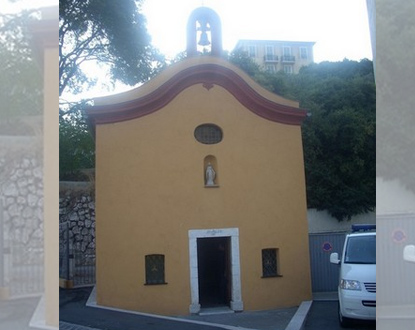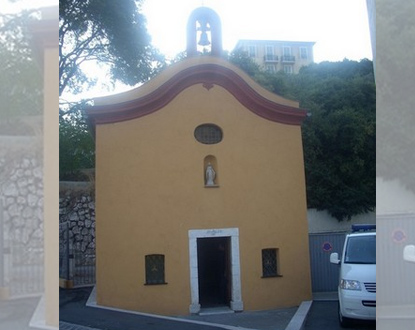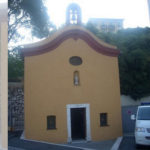During the 2013 Heritage Days, the Federation of Associations of the County of Nice is organizing a guided tour of this restored private chapel (owner Mr. Martin).
The Federation undertook this restoration project over six years.
This visit, organized by volunteers for several years, is always a source of emotion because several residents of the neighborhood are eager to come and share their experiences and exchange very different memories according to each witness…..

In the County, it has always been customary to surround villages or towns with chapels dedicated to a protecting Saint against epidemics (Saint Sebastian, Saint Michael…) or the Virgin Mary.
These chapels were built on the roads at the exact location where one could see the village or town church for the first or last time. Thus in Bon Voyage, we are at the exact spot where one can see Saint Reparata by following the path along the banks of the Paillon.
This place is located on one of the salt roads and then on the “Strada Reale” Nice Turin.
This Chapel, dated 1727 in its current version, is part of the memory of our County, as it was the last place where travelers would gather and place themselves under the protection of the Virgin Mary before embarking on their perilous journey to Turin, the capital of the States of Savoy of which the County of Nice was part.
It was to this chapel that the consuls of Nice would accompany the princes of Savoy who were returning to Turin. On this route, mainly used for trade at the time, one could count over 30,000 mules annually.
Therefore, this chapel represents a very important symbol: it is the starting point of the famous Royal Road (in Italian Strada Reale). At the time, it followed the Paillon Valley, crossed L’Escarène, took the Braus Pass, Sospel in the Bévéra Valley, and continued through the Brouis Pass to join the Roya Valley and ascend through the Tende Pass towards Piedmont. Needless to say, not all travelers came out unscathed from this long and perilous journey.
During the restoration work, the seventeenth-century chapel destroyed at the window level under the eighteenth-century one was rediscovered.
Everything was done to restore the building to its original appearance from the early eighteenth century. The terracotta floor tiles are identical to those we discovered under the 1930s tiling.
The work, supervised by Mr. Antoine GRISI, associate architect of the French Buildings (historical monuments) and carried out by companies approved by Historical Monuments, began in early 2007. They are now completed.
Everything was redone identically: the terracotta floor, lime walls. And, of course, the altar, an example of Baroque art in the County of Nice. Ultimately, the goal is to list the building in the inventory of historical monuments and organize exhibitions and various events.
A traditional bronze bell with six handles, adorned with a Virgin on one side with the inscriptions in Niçois of Our Lady of Bon Voyage and on the other side the coat of arms of Nice, was cast by the Brian Workshops, who offered us the engraving of the Virgin. Thanks to an automatic ringing system, this bell rings every hour between 9 a.m. and 9 p.m.
On the side of the Chapel, we find two remarkable elements: the communal boundary marker delineating Eze and Nice, and the canal, now blocked, which we discovered by removing a pile of mounds of earth and stone: canal of the agricultural plain of Riquier, mentioned in the cadastre of 1812 and 1873; it took its source in the Paillon and descended to the level of the tobacco factory, Barla Street.



